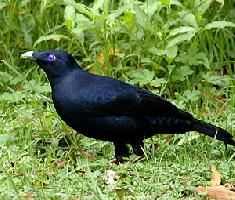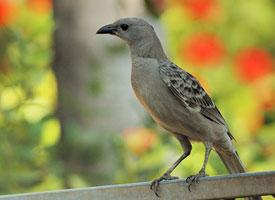
Váhy a míry
| Délka | od 28 do 32 cm |
|---|
Popis zvířete
The Satin Bowerbird (Ptilonorhynchus violaceus) is a remarkable and unique species of bird native to eastern Australia, renowned for its extraordinary courtship behavior and striking appearance. This medium-sized bird is part of the bowerbird family, a group known for the males' intricate and artistic construction of bowers—structures used to attract and woo potential mates.Adult males exhibit a stunning, glossy blue-black plumage that exudes a satin-like sheen, which contrasts sharply with their bright violet-blue eyes, making them one of the more visually captivating avian species. The intensity of their coloration is a product of both the structure of their feathers and the pigmentation, which together create the iridescent effect that is so mesmerizing. In contrast, females and immature males are adorned with a more subdued color palette, featuring a mixture of green, brown, and cream tones that provide excellent camouflage against the forest floor and underbrush.
Satin Bowerbirds are approximately 25 to 35 centimeters in length, with a robust body, strong legs, and a distinctive hooked bill. These features equip them well for their omnivorous diet, which includes fruits, seeds, insects, and small animals.
One of the most fascinating aspects of the Satin Bowerbird's behavior is the construction and decoration of bowers by the males. Unlike nests, which are used for raising young, bowers are elaborate courtship arenas. The male builds a structure, typically an avenue-type bower, consisting of two parallel walls of sticks, placed on the forest floor. The meticulous arrangement and the selection of sticks demonstrate the male's skill and dedication.
What sets the Satin Bowerbird apart is not just the architecture of these structures but the elaborate and obsessive decoration that accompanies them. Males collect a variety of brightly colored objects, such as flowers, berries, and even man-made items like plastic or glass, with a strong preference for blue items that complement their plumage. These objects are strategically placed around the bower to enhance its attractiveness to potential mates.
The bower serves as a stage for a series of complex and highly choreographed courtship displays. The male performs an intricate dance, involving a series of movements, sounds, and mimicked noises, to entice the female into the bower. The female, playing the role of a critical observer, watches from the sidelines, evaluating the male's performance and the quality of his bower before deciding whether to mate with him.
Satin Bowerbirds are found in a variety of forested habitats, ranging from rainforests to woodland areas. They are adaptable birds, capable of living in areas that have undergone some degree of human disturbance, provided that there is sufficient vegetation cover for foraging and bower construction.
Despite their beauty and fascinating behaviors, Satin Bowerbirds face threats from habitat destruction and fragmentation. However, they are currently classified as a species of least concern by the International Union for Conservation of Nature (IUCN), thanks to their wide distribution and relatively stable population numbers.
In summary, the Satin Bowerbird is a captivating example of nature's complexity and creativity. Its striking appearance, combined with its elaborate courtship rituals and bower-building behaviors, make it a subject of great interest and admiration among birdwatchers, ornithologists, and nature enthusiasts alike.
Podobná zvířata
Nové fotografie zvířat
Top 10 zvířat
- Chinese water dragon (Physignathus cocincinus)
- Galápagos tortoise (Geochelone nigra complex)
- Dolphin gull (Leucophaeus scoresbii)
- Japanese macaque (Macaca fuscata)
- Colombian red howler (Alouatta seniculus)
- Sea urchins (Echinoidea)
- Moustached guenon (Cercopithecus cephus)
- Diana monkey (Cercopithecus diana)
- Common reed warbler (Acrocephalus scirpaceus)
- Common house mosquito (Culex pipiens)
